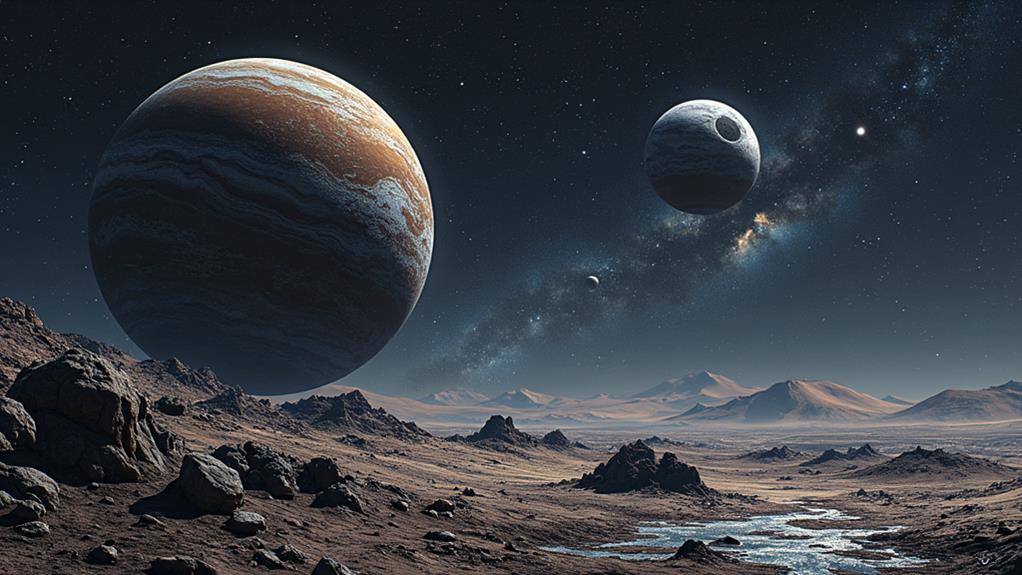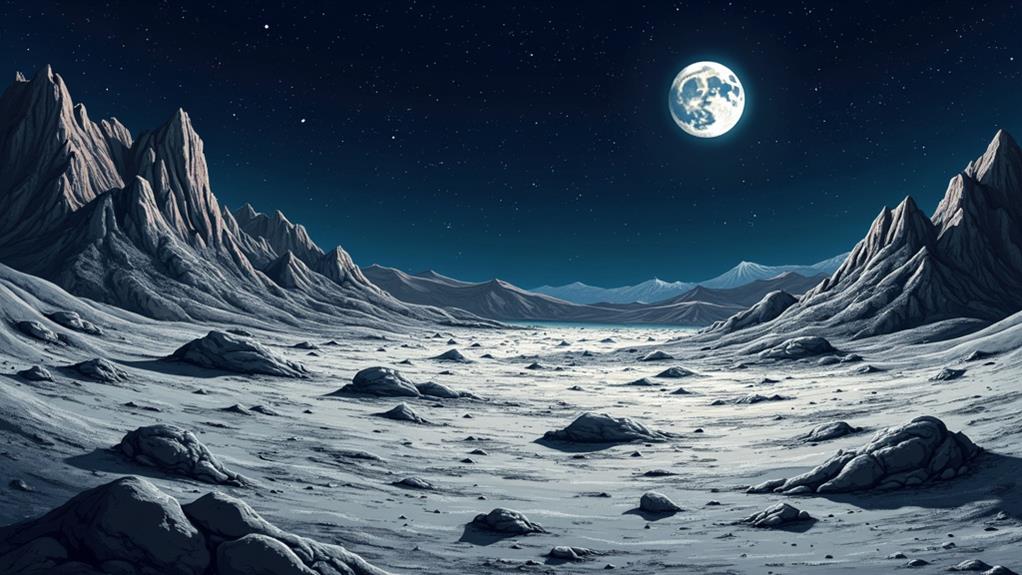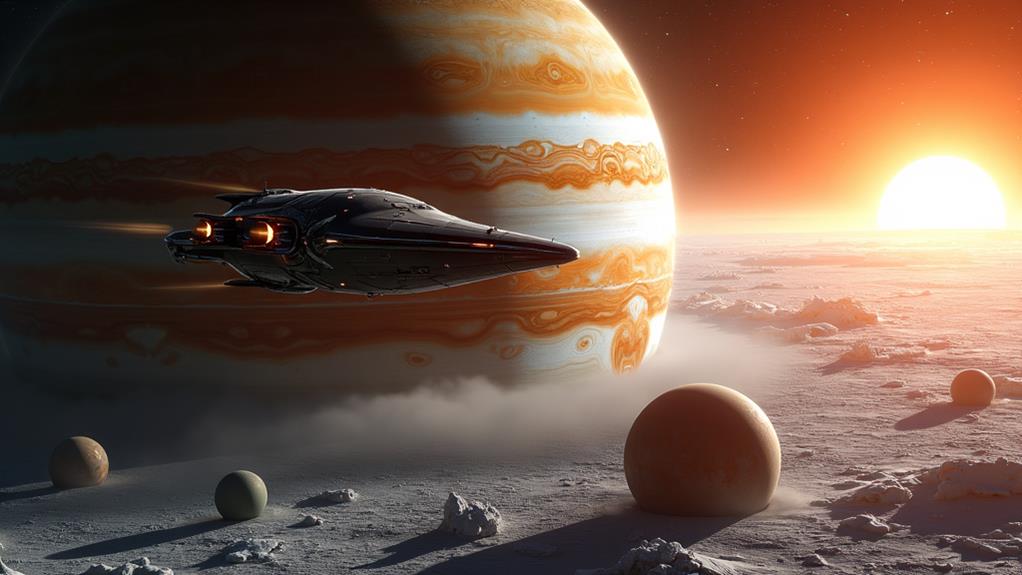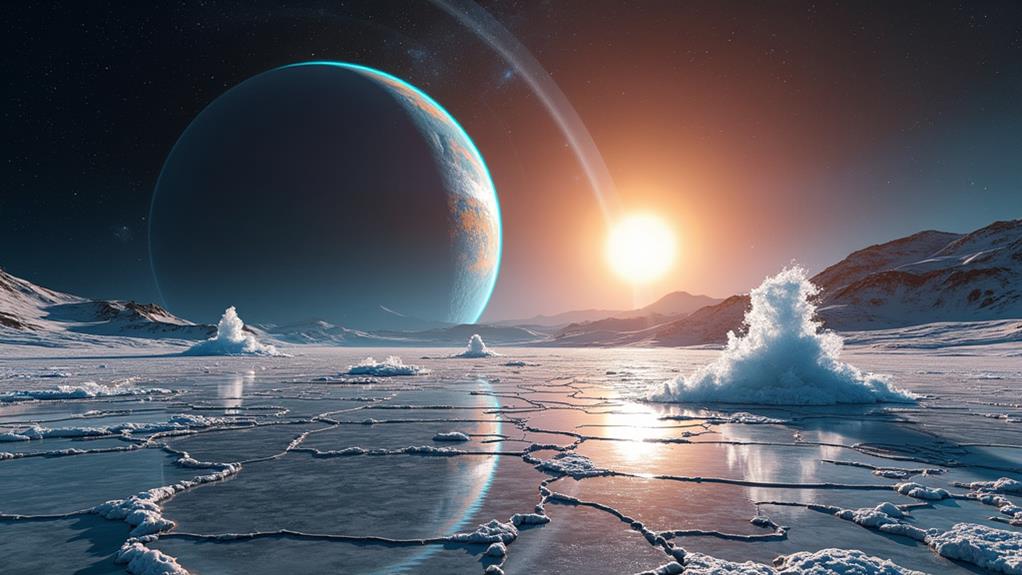Discovering Unique Features of Uranus and Neptune's Moons
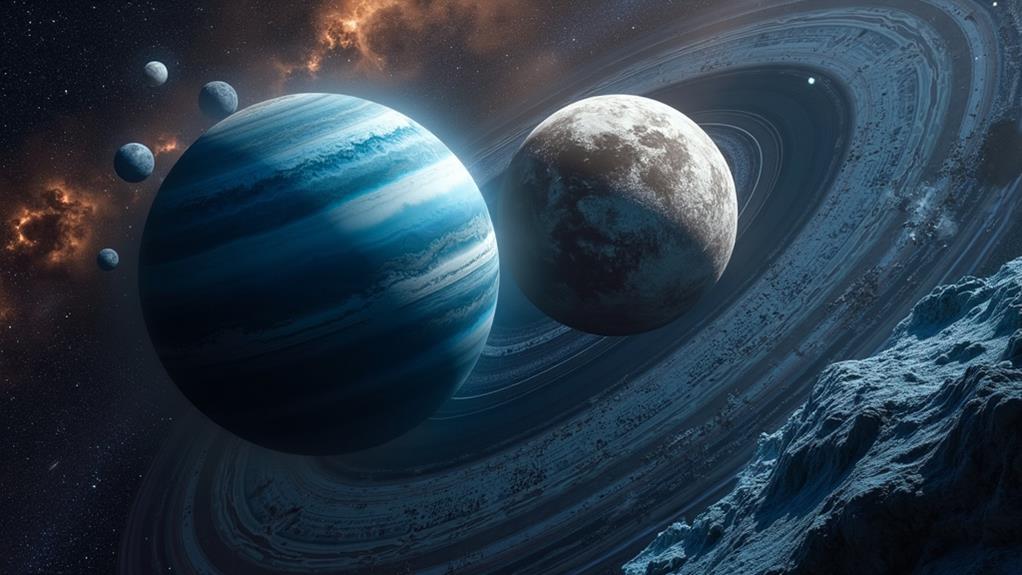
When you investigate Uranus and Neptune's moons, you'll find they're rich with unique features. Uranus has 28 known moons, with Titania, its largest, showcasing significant geological features and Miranda boasting deep canyons. Neptune's 16 moons include newly identified S/2002 N5 and S/2021 N1, which have long, eccentric orbits. Their recent findings reveal fascinating insights into gravitational capture and complex orbital paths. Advanced imaging systems helped detect these moons, expanding your understanding of their dynamic interactions and historical significance. Stay engaged to unearth even more intriguing details about these distant celestial bodies.
Key Takeaways
- Uranus' moon Miranda features deep canyons and terraced layers, indicating significant geological diversity.
- Neptune's moon S/2021 N1 has an elongated orbit, taking approximately 27 years to complete a revolution.
- Newly discovered moons around Uranus and Neptune exhibit eccentric and inclined orbits, suggesting gravitational capture.
- Uranus' largest moon, Titania, has a diameter of about 1,577 kilometers and notable geological features.
- Advanced imaging techniques were critical in identifying three new moons, enhancing our understanding of distant celestial bodies.
Discovery of New Moons
Although the vast reaches of our solar system hold many mysteries, astronomers have recently made significant strides by revealing three new moons orbiting Uranus and Neptune. S/2023 U1, orbiting Uranus, is the initial new moon found around this ice giant planet in over 20 years. Two extra moons, S/2002 N5 and S/2021 N1, were located circling Neptune, further expanding our knowledge of these distant worlds.
The identification of these moons involved advanced image processing techniques, which allowed astronomers to detect some of the faintest objects in the Solar System. By using multiple five-minute exposures over several hours, they managed to distinguish these new moons from the backdrop of stars. S/2023 U1 orbits Uranus every 680 days, while Neptune's moons have more extended orbital periods: nearly nine years for S/2002 N5 and an astonishing 27 years for S/2021 N1.
These findings, confirmed by the International Astronomical Union's Minor Planet Center, were made possible through collaboration among astronomers from Carnegie Science, NASA's JPL, and several universities. This revelation not only increases the total count of moons around Uranus and Neptune but also enriches our understanding of the ice giant planets in our Solar System.
Characteristics of the Moons
The newly uncovered moons of Uranus and Neptune offer fascinating insights into the characteristics of these distant celestial bodies. The Uranian moon S/2023 U1, with a diameter of about 5 miles (8 kilometers), orbits Uranus every 680 days. Neptune's newly found moons, S/2002 N5 and S/2021 N1, measure 14 miles (23 kilometers) and 8.6 miles (14 kilometers) across, respectively. S/2002 N5 completes its orbit around Neptune in nearly 9 years, while S/2021 N1 takes approximately 27 years to circle its planet.
You'll notice that all three moons exhibit eccentric, inclined, and elongated orbits. These unusual paths suggest they were likely captured by the gravitational forces of Uranus and Neptune rather than being formed in place. Such captures offer valuable clues about the dynamic processes at play in the outer solar system.
When it comes to naming conventions, Uranian moons are often named after characters from Shakespeare's plays, reflecting their cultural significance. In contrast, Neptunian moons derive their names from themes in Greek mythology. These naming practices not only celebrate literary and mythological heritage but also enrich our understanding of these celestial wanderers.
Observation Techniques
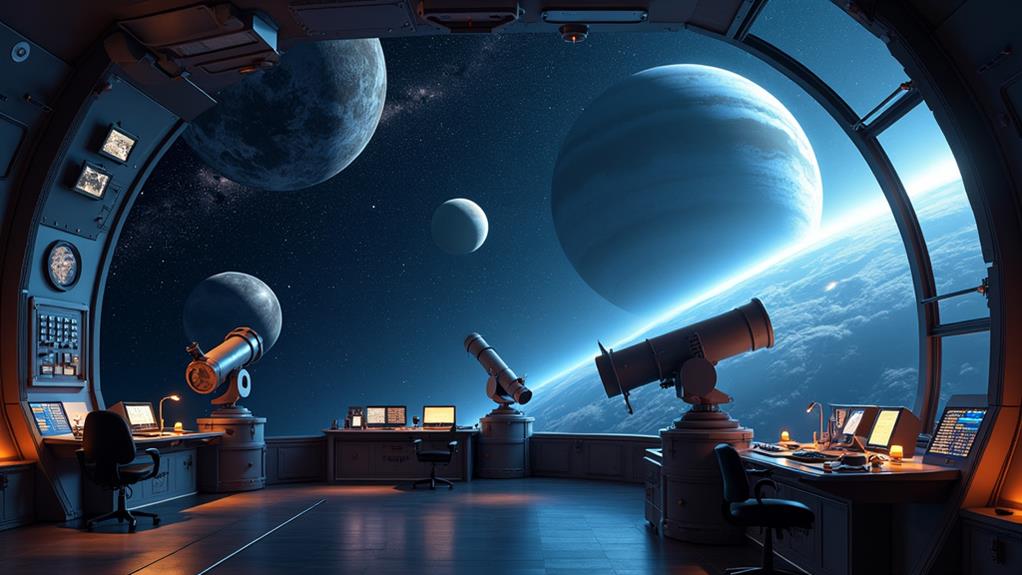
Observing these distant moons involves leveraging advanced ground-based telescopes like the Magellan and Subaru to detect their faint signals. When you're trying to spot the moons of Uranus and Neptune, these telescopes are your best friends. They use sophisticated imaging techniques to capture the faint light from these tiny celestial bodies. You'll need special image processing techniques to make sense of what you see.
One effective method involves stacking dozens of five-minute exposures taken over several nights. This technique helps distinguish moving objects from the static background stars. You'll spend about 15 hours of telescope time for each moon, ensuring you accurately determine their orbits. Ultra-pristine observing conditions are essential; without them, the faint moons might remain hidden against the vast backdrop of space.
For instance, the Uranian moon S/2023 U1 was initially detected in November 2023. Follow-up observations confirmed its orbit using older imagery from 2021. This kind of thorough observation and processing is fundamental to understanding these distant worlds. By combining advanced telescopes, precise imaging, and careful data processing, you can reveal the hidden moons of Uranus and Neptune.
Historical Context
When you immerse yourself in the historical context of Uranus and Neptune's moons, you'll find a rich tapestry of exploration and scientific advancement. Historical observations, particularly the Voyager 2 flyby in 1986, greatly expanded our knowledge of these distant moons. Before this, our understanding was limited, but the Voyager 2 mission revealed a total of 28 known moons around Uranus, each with unique characteristics and histories.
The revelation of new moons, like S/2023 U1, S/2002 N5, and S/2021 N1, suggests that they may have been captured by Uranus and Neptune's gravity during their early formation. This phenomenon of gravitational capture is also seen in other giant planets' moon systems within our Solar System, creating a diverse and intricate moon landscape. The recent findings indicate a complicated history marked by collisions and fragmentation among larger moons, contributing to the dynamic orbital characteristics observed today.
Uranian moons are often named after Shakespearean characters, reflecting a blend of cultural and scientific heritage. These naming conventions highlight the longstanding astronomical tradition and the rich history of our celestial discoveries. Understanding these moons' historical context offers a glimpse into the early dynamics that shaped our Solar System.
Uranian Moons Overview
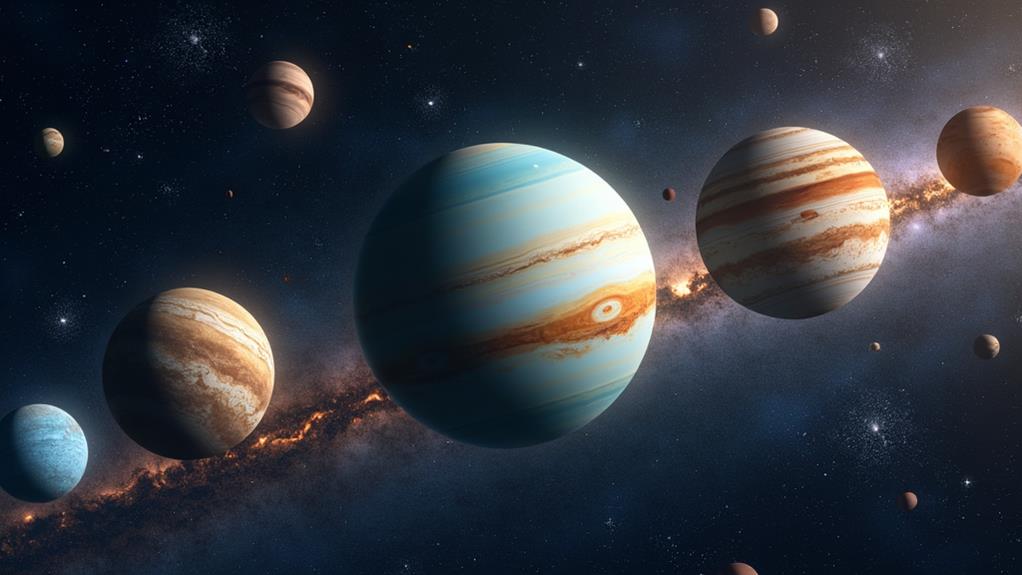
Investigating the moons of Uranus reveals a captivating collection of celestial bodies, each with distinct features and stories. Uranus boasts 28 known moons, with the five largest being Oberon, Titania, Ariel, Umbriel, and Miranda. Uncovered by William Herschel in 1787 and further examined by Voyager 2 in 1986, these moons offer a wealth of geological features and unique characteristics.
Titania, the largest moon, stretches about 1,577 kilometers in diameter and showcases significant geological features that intrigue scientists. Oberon, another major moon, presents a mysterious surface. Meanwhile, Miranda captivates observers with its deep canyons, terraced layers, and varied geological period, making it the most diverse of Uranus's moons.
Interestingly, the inner moons of Uranus are composed of roughly half water ice and half rock, contributing to their unique compositions. Umbriel stands out with its dark surface and ancient craters, hinting at an intriguing history. The naming conventions for Uranian moons are inspired by characters from Shakespeare's works, adding a cultural layer to their scientific nomenclature. As you investigate the moons of Uranus, you'll uncover a remarkable blend of ice, rock, and literary heritage that sets them apart from Neptune's satellites.
Major Moons Features
Shifting focus from the general overview of Uranus' moons, let's examine the distinct features of its major satellites. Miranda stands out with its highly diverse surface marked by deep canyons, terraced layers, and a mix of geological periods, making it one of the most intriguing bodies in the solar system. Ariel, the brightest of Uranus' moons, has few large craters, indicating a relatively youthful surface that has experienced significant geological activity in the past.
Umbriel, the darkest moon, features a heavily cratered surface that is ancient. Its mysterious bright ring starkly contrasts with the surrounding dark terrain, hinting at complex geological processes. Oberon, the largest of Uranus' moons, also displays a heavily cratered surface but with unique dark material within its craters, suggesting a multifaceted geological history.
The interactions between these moons and their environment are similarly fascinating. For instance, shepherd moons Cordelia and Ophelia play essential roles in maintaining the stability of Uranus' epsilon ring. This dynamic interplay between moons and ring systems highlights the intricate and interconnected features of Uranus' celestial neighborhood. Each of these moons, with their distinct characteristics, contributes to the rich tapestry of Uranus' satellite system.
Neptunian Moons Insights
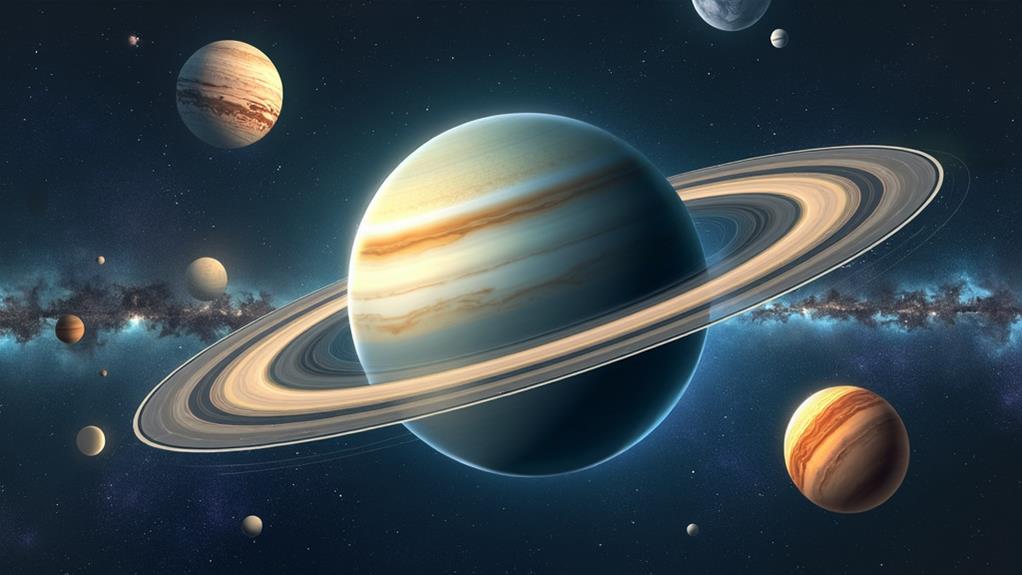
Neptune's moon system continues to captivate astronomers with its diversity and complexity. Recently, two new moons have been identified, bringing the total count to 16. Remarkably, S/2002 N5 stands out with a diameter of approximately 23 kilometers and an orbit that takes nearly 9 years to complete. This moon, along with the faint S/2021 N1, which has a diameter of about 14 kilometers and orbits Neptune in roughly 27 years, adds to the richness of Neptune's celestial ensemble.
The insights gained from these revelations are intriguing:
- Distant Orbits: Both S/2002 N5 and S/2021 N1 exhibit distant orbits, further from Neptune than many other moons.
- Eccentric Paths: Their orbits are not perfectly circular but rather eccentric, indicating a more complex gravitational interaction.
- Inclined Orbits: These moons orbit at inclined angles, suggesting a dynamic capture process.
- Greek Mythology Naming: Following tradition, their names will be inspired by Greek mythology, specifically water deities.
The identification of S/2002 N5, traced back to a 2003 observation, highlights the ongoing efforts to document Neptune's moons. These moons' distant, eccentric orbits suggest they were likely captured by Neptune's gravity during the planet's early formation, adding to the intricate puzzle of our solar system.
Scientific Implications
The recent revelations of Neptune's moons S/2002 N5 and S/2021 N1 bring to light the scientific implications of these findings. By examining these moons' eccentric and inclined orbits, you can appreciate how gravitational capture played a vital role during the early solar system formation. This revelation offers a window into the chaotic processes that shaped Uranus and Neptune's moon systems.
The sizes and orbital characteristics of these moons, like S/2023 U1's 680-day orbit, provide valuable insights into their evolution and dynamics. This information is fundamental for understanding how these celestial bodies interact with their parent planets and other moons. The possibility that these moons are remnants of larger bodies suggests past collisions and fragmentation events, revealing more about the moons' complex history.
Advanced image processing and long exposure photography have been significant in identifying these moons. These techniques not only underscore technological progress but also promise the future identification of even smaller, previously undetectable moons. Ongoing research into these moons' compositions and dynamics will further our grasp of planetary science, enhancing our understanding of interactions within Uranus and Neptune's moon systems and contributing to the broader narrative of solar system formation.
Frequently Asked Questions
What Are Some Unique Features of Neptune's Moons?
Neptune's moons boast fascinating features. Triton has geysers that spew nitrogen. Nereid's orbit is eccentric and elongated. Proteus has a cratered surface, while Despina shows unique geological features. Thalassa's geology remains under study. Naiad's composition is icy, and Larissa shows signs of a massive impact. Halimede's size is small, and Psamathe has an unusual color. Ultimately, Hippocamp's origins remain a mystery.
What Are the Unique Features of Uranus Moons?
Uranus's moons are just mind-blowingly unique! Miranda's cliffs defy gravity with their grandeur. Titania's canyons stretch endlessly, while Oberon's craters tell ancient tales. Ariel's ice glistens like diamonds, contrasting Umbriel's darkness. Portia's orbit is fascinatingly close, and Sycorax's size is colossal. Puck's surface is a riddle, and Caliban's composition hints at mysteries. Prospero's atmosphere is intriguingly thin. Each moon has its own story, waiting to be uncovered by you.
What Are the Features of Uranus and Neptune?
Uranus and Neptune, as ice giants, have distinct features. Uranus' atmosphere is mostly hydrogen and helium, with a unique axial tilt causing extreme seasonal changes. Neptune is famous for its massive storms and strong magnetic field. Both planets have faint ring systems and exhibit temperature extremes. Their orbital patterns and high escape velocity make them fascinating. The planetary geology reveals dynamic processes shaping their surfaces and interiors.
What Is Unique About the Discovery of Uranus?
Imagine peering through the Herschel telescope and coming across Uranus, an ice giant with a magnetic field as quirky as its name. The Uranus finding shook the 18th century's celestial mechanics, revealing a planetary alignment that defied expectations. Its atmospheric composition and ring system were like cosmic jokes, while orbital resonance added a touch of mystery. This historical impact expanded our understanding of the solar system's dynamics, forever changing space exploration.

